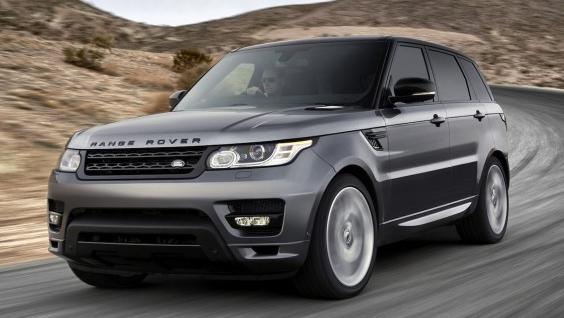The all-new Range Rover Sport will be significantly lighter, faster, more practical and more technologically advanced than ever before when it launches in Australia in November.
Revealed in New York today ahead of its official unveiling at tomorrow’s auto show, the second-generation Range Rover Sport is up to 420kg lighter than its predecessor – down from 2535kg to 2115kg – a feat achieved largely through the luxury SUV’s switch from its old Land Rover Discovery 4-derived separate-chassis underpinnings to an all-aluminium monocoque borrowed from the new Range Rover.
As a result, the new Range Rover Sport will be up to 24 per cent more fuel efficient than the previous model from launch, and even more frugal from 2014 when a diesel hybrid variant, promising combined cycle fuel consumption of approximately 6.4L/100km, is added to the line-up.

Land Rover has also confirmed a sub-2000kg four-cylinder version of the Range Rover Sport – an all-new engine rather than the Ford-sourced 2.0-litre unit in the Range Rover Evoque – will join the range later in the model’s lifecycle. Land Rover Australia brand manager Tim Krieger said the Range Rover Sport Hybrid was locked in for an early-2014 launch in our market, while the four-cylinder model – still “a few years away” – was under consideration.
All four globally available powertrains will be offered in Australia from launch, including the entry-level 190kW/600Nm 3.0-litre TDV6 diesel and the uprated 215kW SDV6 tune, the 250kW/450Nm 3.0-litre supercharged V6 petrol, and the range-topping 375kW/625Nm 5.0-litre supercharged V8 petrol. A 250kW/700Nm 4.4-litre SDV8 petrol will join with the hybrid in early 2014. Each engine is paired with a ZF eight-speed automatic transmission with stop-start technology.
The diesels will be the most fuel efficient, using approximately 7.4L/100km, while unsurprisingly the 5.0-litre V8 will be the quickest, launching from 0-100km/h in 5.3 seconds.
Certain to boost the popularity of the new Range Rover Sport is its introduction of third-row seating, increasing the car’s people-hauling potential from five to seven.
At 4850mm long, the new Sport is just 62mm longer than the outgoing model, yet its significantly longer wheelbase (+178mm) creates an additional 24mm of rear-seat legroom and improved access for third-row passengers.
Land Rover says the new Range Rover Sport takes a significant step forward from a vehicle dynamics perspective.
The electric power steering system is brand new, while Land Rover has also completely re-engineered the car’s four-corner air suspension and upgraded its Dynamic Response and Adaptive Dynamics chassis and stability technologies.
Land Rover says the aluminium suspension system offers class-leading wheel travel – 260mm front, 272mm rear – while the total range of movement from the lowest ‘access height’ (50mm) to the highest off-road height (235mm) has been increased and is now 185mm.
Approach and departure angles now measure 33 and 31 degrees respectively, while the Range Rover Sport’s wading depth has increased 150mm to 850mm thanks to a new air intake system.
A new Dynamic Mode in the Sport’s Terrain Response 2 system has been designed to facilitate enthusiastic on-road driving, resulting in a firmer ride, tighter body control, reduced roll and more responsive steering and performance.
The second-generation Terrain Response system features an Auto setting, which uses sensors and other ‘intelligent’ systems to analyse the driving conditions and select the best set-up from one of five drive modes: General, Grass/Gravel/Snow, Mud/Ruts, Sand, and Rock Crawl. The system also provides the driver with tips on when to select low range or to adjust the vehicle’s ride height.
Enhancing performance is the dynamic active rear locking differential and torque vectoring – a first for Range Rover – which transfers torque to the outside wheels during cornering to reduce understeer.
Two full-time all-wheel-drive systems are available. The first provides a two-speed transfer case with a low-range option designed for the most demanding off-road conditions. By default, torque is split 50:50 front to rear, but can be distributed entirely to the front or rear depending on the circumstances.
The second is a single-speed transfer case with a Torsen differential that is 18kg lighter and designed to offer optimum driving dynamics. A 42:58 front-to-rear split is the default setting, although that can vary between 62 per cent front and 78 per cent rear depending on the grip available.
Another Range Rover first is the Sport’s Wade Sensing system, which provides the driver information about the depth of water they are driving through, delivering visual and audible warnings if the water level rises around the vehicle.
A host of other driver-assist safety technologies will be available in the new Range Rover Sport, including lane departure warning, blind spot monitoring, traffic sign recognition, auto high-beam assist, adaptive cruise control, reverse traffic detection, and automatic reverse parking.
In front of the driver sits Land Rover’s first ever head-up display unit, which projects key vehicle and navigation data onto the windscreen in the driver’s line of sight. It is supported by a 12.3-inch high-resolution instrument cluster screen and an eight-inch touchscreen with optional Dual View (different screens visible from the driver and passenger seats) for access to infotainment and other functions.
The new Range Rover Sport will be offered in most markets in four specification levels: S, SE, HSE and Autobiography. Personalisation is another highlight of the new model, with customers able to select from 19 exterior paint colours, three contrasting roof colours, nine alloy wheel designs across the available 19-, 20-, 21-, and 22-inch sizes, 11 interior colour themes, four aluminium trim finishes, three real wood veneers and three headliner colours.
While he would not be drawn on pricing, Krieger said the new Sport would be “competitive” with the likes of the BMW X5 and Mercedes-Benz ML. He suggested a dip under the current car’s six-figure entry pricing was unlikely.
Australian prices and specifications of the Range Rover Sport will be announced in July ahead of its November launch.





